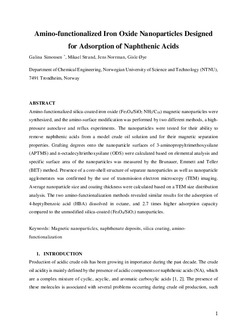| dc.contributor.author | Simonsen, Galina | |
| dc.contributor.author | Strand, Mikael | |
| dc.contributor.author | Norrman, Jens | |
| dc.contributor.author | Øye, Gisle | |
| dc.date.accessioned | 2020-01-21T08:54:49Z | |
| dc.date.available | 2020-01-21T08:54:49Z | |
| dc.date.created | 2019-04-30T17:34:45Z | |
| dc.date.issued | 2019 | |
| dc.identifier.citation | Colloids and Surfaces A: Physicochemical and Engineering Aspects. 2019, 568 147-156. | nb_NO |
| dc.identifier.issn | 0927-7757 | |
| dc.identifier.uri | http://hdl.handle.net/11250/2637151 | |
| dc.description.abstract | Amino-functionalized silica-coated iron oxide (Fe3O4/SiO2 NH2/C18) magnetic nanoparticles were synthesized, and amino-surface modification was performed with a high-pressure autoclave experiment and newly developed reflux procedure. The nanoparticles were tested for their ability to remove naphthenic acids from a model crude oil solution and for their magnetic separation properties. Grafting degrees onto the nanoparticle surfaces of 3-aminopropyltrimethoxysilane (APTMS) and n-octadecyltriethoxysilane (ODS) were calculated based on elemental analysis and specific surface area of the nanoparticles was measured by the Brunauer, Emmett and Teller (BET) method. Presence of a core-shell structure of separate nanoparticles as well as nanoparticle agglomerates was confirmed by the use of transmission electron microscopy (TEM) imaging. Average nanoparticle size and coating thickness were calculated based on a TEM size distribution analysis. The two amino-functionalization methods revealed similar results for the adsorption of 4-heptylbenzoic acid (HBA) dissolved in octane, and 2.7 times higher adsorption capacity compared to the unmodified silica-coated (Fe3O4/SiO2) nanoparticles. | nb_NO |
| dc.language.iso | eng | nb_NO |
| dc.publisher | Elsevier | nb_NO |
| dc.rights | Navngivelse-Ikkekommersiell 4.0 Internasjonal | * |
| dc.rights.uri | http://creativecommons.org/licenses/by-nc/4.0/deed.no | * |
| dc.title | Amino-functionalized iron oxide nanoparticles designed for adsorption of naphthenic acids | nb_NO |
| dc.type | Journal article | nb_NO |
| dc.type | Peer reviewed | nb_NO |
| dc.description.version | acceptedVersion | nb_NO |
| dc.source.pagenumber | 147-156 | nb_NO |
| dc.source.volume | 568 | nb_NO |
| dc.source.journal | Colloids and Surfaces A: Physicochemical and Engineering Aspects | nb_NO |
| dc.identifier.doi | 10.1016/j.colsurfa.2019.02.010 | |
| dc.identifier.cristin | 1694889 | |
| dc.relation.project | Norges forskningsråd: Norges forskningsråd /NORTEM 197405 | nb_NO |
| dc.description.localcode | © 2019. This is the authors’ accepted and refereed manuscript to the article. Locked until 5 May 2021 due to copyright restrictions. This manuscript version is made available under the CC-BY-NC-ND 4.0 license http://creativecommons.org/licenses/by-nc-nd/4.0/ | nb_NO |
| cristin.unitcode | 194,66,30,0 | |
| cristin.unitname | Institutt for kjemisk prosessteknologi | |
| cristin.ispublished | true | |
| cristin.fulltext | postprint | |
| cristin.qualitycode | 1 | |

